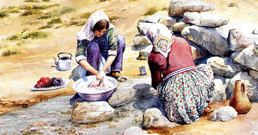The Iranian-Armenian watercolorist Sumbat Der Kiureghian was born in 1913 in Iran, lived there until 1980, and then moved to the United States where he died in 1999. He is renowned within artistic circles throughout the world for his astonishingly colourful alluring aquarelles. Although in Iran Sumbat is not among the most acclaimed artists of the country, exporting his works has been forbidden as they are considered a part of Iranian national treasure. In these multi-media reports Professor Armen Der Kiureghian of UC Berkeley depicts his father’s profile and outlines Sumbat’s specific techniques in painting. Professor Der Kiureghian published a book titled ‘The Life and Art of Sumbat’ in 2009. The following article is a shortened version of the foreword to the book by the cultural anthropologist, Levon Abrahamian
Levon Abrahamian
The life of any major artist is the story of the works he has created. At times the artist’s life entails subordinating everything to one’s creative work, serving with absolute and fanatical devotion to art, during which family and friends are disregarded. The case of Sumbat Der Kiureghian, however, is an example of a calm and harmonious synthesis of life and art. The process of creating seems to come to him without torturous struggle; it seems to be a natural and integral part of his full life. He even found his love and life partner through the course of creating, when making a painting of the Sourb Amenaprkitch monastery from the balcony of his future wife’s home.
The works of renowned watercolourist Sumbat Der Kiureghian were declared Iranian national treasures and in the 1990s their export from Iran was forbidden. The artist, born of Armenian descent, found it natural to use his first name as his nom d’art.
As described elsewhere in this book, there are different opinions regarding the ‘national identity’ of Sumbat’s art. For me, of most interest is the cultural dimension of his work. Like his Nor Jugha ancestors, Sumbat undoubtedly assumed the role of a mediator, importing the Western, figurative worldview into Iranian culture. At the same time, his aquarelles are magnificent portrayals of the Iranian world (landscapes, cultural monuments, mode of life) to the Western viewer in an easily intelligible language. It must be stressed that his depictions of rural and sometimes urban life never hinted Orientalism. Sumbat was not a detached observer of Iranian culture, but its empathic participant and bearer, such that he could not be tempted by trivial exotica…
Sumbat’s affinity for ethnography is confirmed by the fact that he had excellent knowledge of the practices and technologies of the phenomena he depicted. The technique of watercolour also allowed for the convergence of the artist and the ethnographer, as it required speed and accuracy. At times, he took photographs instead of making sketches, intending to use the images to complete his work after returning home. This is analogous to the ethnographer, who takes notes in the field in order to describe his observations in detail after returning from an expedition. The best example of this practice are Sumbat’s vivid watercolours presenting scenes of Armenian rural weddings, which the artist created in the United States on the basis of his field photographs and his impeccable colour memory…
The artist’s inner multiculturalism is evident from his use of both Armenian and Farsi newspapers for his Sumbatisms. While later on Sumbat planned which newspapers he would use, at times even coordinating the content of the article with the image he wanted to create, in the early Sumbatisms, the language and content of the newspaper combined randomly with the colour patches, creating something like a hidden subconscious – as if embodying the multicultural essence of the artist



